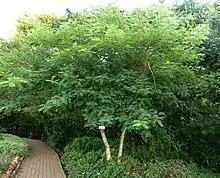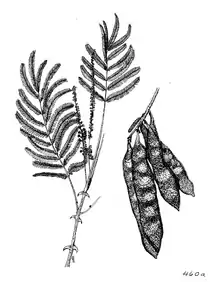| Senegalia polyacantha | |
|---|---|
 | |
 | |
| Scientific classification | |
| Kingdom: | Plantae |
| Clade: | Tracheophytes |
| Clade: | Angiosperms |
| Clade: | Eudicots |
| Clade: | Rosids |
| Order: | Fabales |
| Family: | Fabaceae |
| Subfamily: | Caesalpinioideae |
| Clade: | Mimosoid clade |
| Genus: | Senegalia |
| Species: | S. polyacantha |
| Binomial name | |
| Senegalia polyacantha (Willd.) Seigler & Ebinger | |
| Subspecies | |
| |
| Synonyms[1] | |
Senegalia polyacantha, also known as white thorn, is a flowering tree which can grow up to 25m tall. Polyacantha has the meaning "many thorns" in Latin.[2] The tree is native to Africa, India, the Indian Ocean and Asia, but it has also been introduced to the Caribbean.[1]
Uses
Repellent uses
The root of Senegalia polyacantha subsp. campylacantha emits chemical compounds that repel animals including rats, snakes and crocodiles.[2]
Gum
The tree's gum is used in the manufacture of candy.[2]
Medicinal purposes
Senegalia polycantha's roots and perhaps its bark have medicinal uses. The root extract is useful for snakebites[2] and is applied to wash the skin of children who are agitated at night time.[2] The root is also used for treating gonorrhea,[3] venereal diseases,[4] dysentery[4] and gastrointestinal disorders.[4]
Tannin
Wood
References
- 1 2 ILDIS LegumeWeb(ILDIS)
- 1 2 3 4 5 6 PlantZAfrica.com
- ↑ van der Maesen, L. J. G.; van der Burgt, X. M.; van Medenbach de Rooy, J. M. (1996). The Biodiversity of African Plants. Springer Science+Business Media. p. 254. ISBN 0792340957. Retrieved 10 November 2012.
- 1 2 3 Uhlig, Siegbert (2003). Encyclopaedia Aethiopica: A-C. Harrassowitz Verlag. p. 66. ISBN 3447047461. Retrieved 10 November 2012.
- ↑ Speedy, Andrew. "Acacia polyacantha". www.fao.org. Retrieved 3 August 2017.
External links
 Media related to Senegalia polyacantha at Wikimedia Commons
Media related to Senegalia polyacantha at Wikimedia Commons Data related to Senegalia polyacantha at Wikispecies
Data related to Senegalia polyacantha at Wikispecies- Acacia polyacantha in West African plants – A Photo Guide.